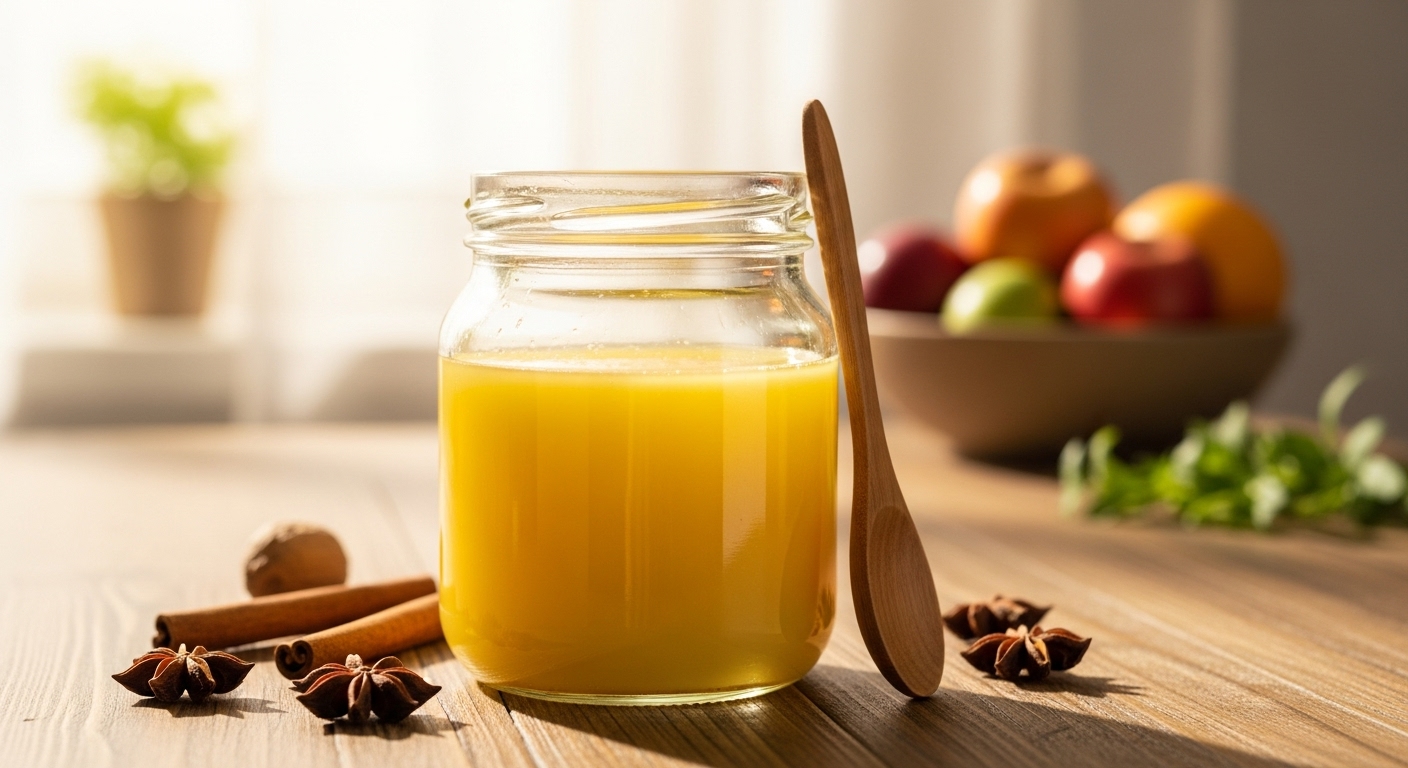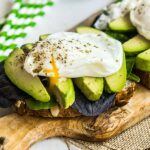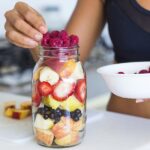
Ghee: A Comprehensive Analysis of India’s “Liquid Gold,” from Ayurvedic Tradition to Clinical Evidence and its Impact on the Microbiota
I. Introduction: Defining an Ancestral Food
Ghee is a type of clarified butter that holds a central place in the cuisine, traditional medicine, and culture of the Indian subcontinent. Although often translated simply as “clarified butter,” the term “ghee” carries a specific cultural and production context that sets it apart.
The process of making ghee is fundamental to understanding its properties. It is prepared by slowly heating butter to remove the water content and allow the milk solids (primarily the protein casein and the milk sugar, lactose) to separate from the pure fat. These solids fall to the bottom and are toasted, caramelizing slightly, which imparts ghee’s characteristic golden color and nutty flavor. The resulting pure, liquid fat is filtered, leaving a product with a fat content close to 100%.
The traditional Desi method in India involves an additional step: the milk is first cultured (fermented) to make curd, which is then churned to obtain butter before being clarified. Modern industrial methods may skip this culturing step.
This very simplicity of production is the source of ghee’s complex duality in modern nutrition. The heating process that removes lactose and casein also creates a product with a very high smoke point, ideal for cooking. However, this same heating introduces biochemical risks, such as the formation of oxidized cholesterol. On one hand, ghee is revered in India as a sacred elixir, a “liquid gold” ; on the other, Western nutrition has historically viewed it with suspicion due to its extremely high saturated fat content. This report will analyze this duality, bridging the gap between ancestral wisdom and modern scientific evidence.
II. Origins and History: The Journey of Ghrita
Ghee’s origins trace back to ancient India, with estimates placing its development between 1500 and 500 BCE, coinciding with the domestication of cattle. Its creation was, first and foremost, a practical innovation. In India’s warm climate, fresh butter quickly spoiled. The clarification process removed water and milk solids—components that harbor bacteria and promote spoilage—creating a stable fat that could be preserved for months without refrigeration.
Ghee in Vedic and Ayurvedic Texts
Ghee, known in Sanskrit as Ghrita (घृत), quickly transcended its culinary use to become a cornerstone of Ayurvedic medicine. It is mentioned prominently in the Brihat Treya, the three great classical texts of Ayurveda, including the Caraka Samhita (c. 500 BCE).
In these texts, the therapeutic properties attributed to Ghrita are extraordinary. The Caraka Samhita states that ghee: “promotes memory, intelligence, agni (digestive fire), semen, ojas (the vital essence of immunity and energy), Kapha and medas (body fat). It alleviates Vata (energy of movement) and Pitta (energy of metabolism)… it is the best of all fats… has 1000 potentialities and, if used properly… exerts 1000 types of action.” Ayurveda also considers it an anupana (a vehicle) that can enhance the absorption and efficacy of medicinal herbs.
A systematic review of Ayurvedic literature spanning 3000 years identified 774 specific therapeutic mentions for ghee, the highest number among all dairy products analyzed, highlighting its central role in the system.
Cultural and Ritual Significance
Beyond medicine, ghee is deeply rooted in Hindu spirituality. It is considered a symbol of purity, auspiciousness, and divine nourishment. It is a sacred requirement in Vedic fire rituals (yajña and homa), where it is poured into the flames as an offering to deities. The cow, from which it is traditionally obtained, is considered sacred in India, adding another layer of sanctity to ghee.
This symbolism extends to Buddhism, where ghee is used in the Nirvana Sutra as a metaphor for the final and purest stage of spiritual enlightenment—the refined product that emerges from milk (initial stages). Although its roots are in India, its use historically spread to Arab and North African cuisines , and it has recently gained global popularity in diets like Paleo and ketogenic.
III. Biochemical Composition: A Detailed Analysis of the Nutritional Profile
Ghee’s composition is the key to its benefits and risks. It is a food of extremely high energy density, composed almost entirely of fat.
- Macronutrient Profile: Ghee contains approximately 99.5% fat. It has virtually no carbohydrates, fiber, or sugars. The protein content is minimal, around 0.3 g per 100 g. Due to its clarification process, it is essentially free of lactose and casein.
- Caloric Content: It is extremely calorie-dense. Values vary slightly but are around 894 kcal per 100 g. A single tablespoon (approximately 14 g) contains about 107 kcal.
- Fatty Acid Profile: This is where the nutritional controversy lies.
- Saturated Fats: It is predominantly a saturated fat. Figures range from 51% to 61.9% of its total fat content.
- Monounsaturated Fats: These make up approximately 28.7%.
- Polyunsaturated Fats: It has a low content, around 3.7%.
- Cholesterol: Ghee contains a significant amount of dietary cholesterol, approximately 256 mg per 100 g.
Key Bioactive Components
Beyond its basic fat profile, ghee is valued for its bioactive components, which are not commonly found in refined vegetable oils.
- Fat-Soluble Vitamins: It is a rich source of vitamins A, D, E, and K. It is particularly noted for its vitamin K2 content , a vitamin difficult to obtain in the modern diet that is crucial for bone and cardiovascular health (helping direct calcium to bones and away from arteries). It can also provide small amounts of vitamin B12.
- Conjugated Linoleic Acid (CLA): Ghee, especially from grass-fed cows , is a source of CLA. CLA is a type of fatty acid that research has associated with anti-inflammatory, antioxidant, and potentially anti-atherogenic properties.
- Butyric Acid (Butyrate): Ghee is the richest known natural dietary source of butyric acid, a short-chain fatty acid (SCFA). This component is fundamental and forms the direct link between ghee and gut health, as will be discussed in Section V.
- Minerals: It contains trace amounts of various minerals, including calcium, phosphorus, chromium, zinc, copper, and selenium.
Table 1: Comparative Profile of Culinary Fats (Approximate values per 100 g)
| Characteristic | Ghee | Butter | Olive Oil (Extra Virgin) | Coconut Oil (Virgin) |
| Calories (kcal) | 894 | 717 | 884 | 862 |
| Total Fat (g) | 99.5 | 81 | 100 | 100 |
| Saturated Fat (g) | 61.9 | 51 | 14 | 87 |
| Monounsaturated Fat (g) | 28.7 | 21 | 73 | 6 |
| Polyunsaturated Fat (g) | 3.7 | 3 | 11 | 2 |
| Cholesterol (mg) | 256 | 215 | 0 | 0 |
| Key Vitamins | A, E, K2 | A, D | E, K | Traces |
| Butyric Acid | ~4.0% | ~3-4% | 0 | 0 |
| Smoke Point | 250°C (485°F) | 175°C (350°F) | ~190-207°C | ~177°C |
IV. General Benefits and Culinary Applications
Ghee’s physical and chemical properties give it several distinct advantages in the kitchen and for certain dietary profiles.
Culinary Advantage 1: The High Smoke Point
Ghee’s most cited benefit is its high smoke point, which is around 250°C (485°F). This is significantly higher than butter’s (175°C / 350°F) and higher than many unrefined vegetable oils, including extra virgin olive oil.
The smoke point is the temperature at which a fat begins to break down and smoke. Ghee’s high smoke point is due to the removal of the milk solids, which are what burn at lower temperatures in butter. This makes ghee a preferred choice for high-heat cooking methods like sautéing, frying, and roasting, as it can withstand more heat before degrading.
Culinary Advantage 2: Oxidative Stability
Ghee is a predominantly saturated fat. While this is a concern for cardiovascular health (see Section VII), it gives it high structural stability. Unlike oils rich in polyunsaturated fats (PUFAs), such as corn, soy, or sunflower oil, the saturated fats in ghee are less susceptible to oxidation (lipid peroxidation) when exposed to heat.
Oxidation creates free radicals and toxic compounds. Some studies suggest that ghee produces less acrylamide (a potentially harmful chemical formed in starchy foods at high temperatures) compared to other vegetable oils when heated to 180°C. However, this stability is a half-truth, as will be detailed in Section VII, as it does not account for the oxidation of its own cholesterol.
Benefit for Dairy Sensitivity
The clarification process effectively removes the vast majority of lactose (sugar) and casein (protein). This makes ghee a viable dairy fat that is generally well-tolerated by people with lactose intolerance or casein sensitivity, allowing them to enjoy a buttery flavor without the associated digestive discomfort.
Flavor and Preservation
The toasting of the milk solids during its production gives ghee a deeper, richer, and nuttier flavor than butter. It is used not only as a cooking fat but also as a finishing oil to enhance the flavor of dishes. Furthermore, its very low moisture content and high fat content make it shelf-stable, requiring no refrigeration, which aligns with its historical purpose of preservation.
V. The Gut Axis: Ghee’s Critical Relationship with the Microbiota
While ghee’s culinary benefits are clear, its most profound biological impact, according to emerging research, may lie in its interaction with the digestive system and the gut microbiota. This area of study bridges the gap between ancient Ayurvedic claims about agni (digestive fire) and the modern science of the microbiome.
Butyric Acid: A Dual-Role Fuel
The protagonist of this story is butyric acid, or butyrate. This short-chain fatty acid (SCFA) is vital for colon health and plays a dual role :
- Exogenous Source (Dietary): Ghee is the richest known natural food source of butyric acid.
- Endogenous Source (Microbial): The body produces its own butyrate. Specifically, beneficial bacteria in the colon (like Clostridium butyricum) ferment dietary fiber (prebiotics) and produce butyrate as a byproduct.
Mechanism 1: Ghee as a Nutrient, Not a Probiotic
It is crucial to clarify a common misconception: ghee is not a probiotic; it does not contain live bacteria. Its function is fundamentally different. The butyrate consumed through ghee acts as direct nutrition or fuel for the colonocytes, the cells lining the colon.
An adequate supply of butyrate is essential for maintaining the integrity of the intestinal barrier. It helps repair the colon lining, supports mucosal function, and reduces gut inflammation. This is why butyrate is studied for its potential to help in conditions like intestinal permeability (“leaky gut”) and inflammatory bowel disease.
Mechanism 2: Positive Microbiota Modulation
Beyond simply providing fuel, pre-clinical evidence suggests that components in ghee can actively modulate the composition of the gut microbiota. A study in animal models investigating branched-chain fatty acids (BCFAs) from yak ghee found that their administration improved microbiota health.
Key findings included:
- Increase in Beneficial Bacteria: A significant increase in the relative abundance of Akkermansia and Lactobacillus was observed. Akkermansia is particularly notable for its role in maintaining the intestinal mucus layer, which is a critical defensive barrier.
- Reduction in Pathogenic Bacteria: There was a significant decrease in the abundance of Helicobacter and Proteobacteria, phyla often associated with inflammation and disease.
Microbiome Synergy: A Virtuous Cycle
These mechanisms do not act in isolation; they create a synergistic, virtuous cycle. Ghee consumption appears to act as a catalyst for overall gut health:
- Exogenous butyrate (from ghee) provides an immediate fuel supply to repair and nourish the gut lining cells (colonocytes).
- A healthier, less inflamed gut lining creates a more stable and hospitable “terrain” or gut environment.
- This improved environment allows beneficial bacteria (probiotics), such as Akkermansia and Lactobacillus (which can be inhibited in an inflamed gut), to proliferate and establish themselves.
- These beneficial bacteria, in turn, consume dietary fiber (prebiotics) and produce more endogenous butyrate.
Therefore, ghee not only provides the end-product (butyrate) but also appears to foster an ecosystem that is better at manufacturing its own butyrate. This aligns perfectly with the Ayurvedic view of ghee as an agni (digestion) promoter that lubricates the digestive tract and enhances nutrient absorption.
VI. Clinical Benefits: Bridging Ayurveda and Modern Science
When evaluating the clinical benefits of ghee, a fundamental disconnect emerges between what traditional medicine values and what modern science has chosen to study.
The Research Focus Mismatch
A 2023 review comparing 3000 years of Ayurvedic texts with modern scientific literature (1990-2023) revealed this gap strikingy.
- Ayurvedic Focus (Top 3): Ayurvedic texts prioritize ghee’s benefits for:
- Cognition: (Memory, intellect).
- Gastrointestinal Health: (Agni, digestion).
- Nutrition/Immunity: (Building Ojas or vital essence).
- Modern Scientific Focus (Top 3): Research on PubMed has primarily focused on:
- Cardiovascular Health: (Effects on cholesterol).
- Wound Healing:.
- Skin Health:.
This disconnect is crucial. Modern science has dedicated most of its resources to investigating cardiovascular health, often concluding with mixed or negative results, while Ayurveda’s primary claims (cognition and digestion) have been far less studied.
Table 2: Ghee: Ayurvedic Perspective vs. Modern Scientific Focus
| Focus Area | Ayurvedic Claims/Focus (Ghrita) | Modern Science Focus/Findings (1990-2023) |
| Cognition/Neurology | Primary Focus. Promotes memory, intelligence, concentration. | Minimal Focus. Few studies (<10%). Gut-brain axis (butyrate) is explored. |
| Gastrointestinal Health (Agni) | Primary Focus. Stimulates agni (digestion), lubricates tract, soothes inflammation. | Secondary Focus. Butyrate nourishes colonocytes and supports the gut barrier. |
| Immunity/Nutrition (Ojas) | Primary Focus. Considered a Rasayana (rejuvenator) that builds ojas (vitality). | Minimal Focus. Anti-inflammatory properties of CLA and butyrate are studied. |
| Cardiovascular Health | Secondary mention. | Primary Focus. Intense focus on lipid profile (cholesterol, triglycerides). |
| Skin/Wound Health | Secondary mention. Used topically to moisturize. | Primary Focus. Significant research focus on wound healing. |
Potential Benefits (Component-Based)
Although large-scale human clinical trials on Ayurvedic claims are limited, ghee’s biochemical components provide plausible mechanisms for its benefits:
- Anti-inflammatory Properties: Ghee contains both CLA and butyric acid, both known for their potent anti-inflammatory effects. Pre-clinical research suggests these components can modulate inflammation pathways and oxidative stress.
- Cognitive and Neurological Health: The Ayurvedic claim that ghee “feeds the brain” aligns with the modern science of the gut-brain axis. A healthy gut, supported by butyrate, is directly linked to the integrity of the blood-brain barrier and improved neuronal function.
- Bone and Joint Health: Emerging research is exploring ghee’s role in bone health. Its unique combination of vitamin K2 (for bone mineralization) and vitamin D (for calcium absorption), along with the anti-inflammatory effects of CLA, may offer support for bone density (osteoporosis) and joint inflammation (arthritis).
VII. Risk Analysis, Controversies, and Contraindications
Despite its benefits, ghee is perhaps one of the most controversial fats in modern nutrition. Its risks center on two main areas: its high saturated fat content and the formation of oxidized cholesterol.
Controversy 1: The Cardiovascular Paradox (Saturated Fat vs. CLA)
The primary argument against ghee is its lipid profile: it is approximately 51-62% saturated fat. Dietary guidelines have long recommended limiting saturated fats, as they can raise LDL (“bad”) cholesterol and the risk of heart disease.
However, human studies on ghee and blood lipids have yielded confusing and seemingly contradictory results. The resolution to this contradiction lies not in which study is “correct,” but in understanding that they were measuring different things.
- The “Negative” Evidence: A high-quality randomized crossover trial compared diets rich in ghee to diets rich in olive oil (the cardioprotective gold standard). The results showed the ghee diet significantly increased two key markers of cardiovascular risk: Apolipoprotein B (Apo B) (a measure of the number of atherogenic lipoprotein particles) and non-HDL cholesterol, compared to the olive oil.
- The “Neutral” Evidence: A 2025 systematic review and meta-analysis that pooled results from eight studies concluded that ghee consumption does not appear to have a significant impact on the overall lipid profile (Total Cholesterol, LDL, HDL) in humans. It did, however, note a possible association with a “marginally increased risk” of coronary heart disease.
- The “Positive” Evidence: A 2023 prospective interventional study gave human volunteers 35 grams of native cow ghee daily for six weeks. The results showed that ghee significantly reduced Total Cholesterol (TC) and LDL Cholesterol (LDL-C). However, this effect was only seen in the dyslipidemic subgroup (those who already had high lipids). In normolipidemic (healthy) volunteers, it had no significant effect.
- The Pre-clinical Evidence (Source-Dependent): The most positive animal studies used CLA-enriched ghee. One rat study with high-CLA ghee showed notable protection: decreased plasma cholesterol (52%), decreased triglycerides (30%), and increased HDL (“good”) (33%). Other rat studies with standard ghee have shown an increase in triglycerides.
Synthesis of the Controversy: Ghee’s effect on the heart is not a simple “yes” or “no” answer. It is highly context-dependent:
- Quality: Grass-fed ghee, high in CLA, may have a protective profile that grain-fed ghee does not.
- Population: It may have a modulating (lowering) effect on unbalanced (dyslipidemic) lipids, but a neutral effect on healthy individuals.
- Comparison: Ghee is almost certainly less cardioprotective than olive oil (rich in monounsaturated fats).
Table 3: Summary of Cardiovascular Clinical Evidence (Human Trials)
| Study (Author/Year) | Study Type | Population | Intervention | Comparison | Key Lipid Findings |
| Crossover Trial | Randomized crossover trial | Healthy adults | Ghee-rich diet | Olive oil-rich diet | Significantly increased Apo B and Non-HDL Cholesterol. No change in LDL or HDL. |
| **Intervention Study ** | Prospective intervention | Healthy volunteers (Normo- & Dyslipidemic) | 35g Ghee/day | Baseline (before) | Significantly reduced TC and LDL-C only in the dyslipidemic group. No change in the healthy group. |
| Meta-Analysis | Systematic review & Meta-analysis (8 studies) | General population | Ghee consumption | Control/Baseline | No significant impact on overall lipid profile. Marginally increased coronary risk. |
Controversy 2: The Hidden Danger of Oxidized Cholesterol (Oxysterols)
Ghee’s most significant and least-discussed risk is the formation of oxidized cholesterol, also known as oxysterols. This problem arises directly from its production method and its culinary use.
The public often confuses “smoke point” with “safety.” The argument is that since ghee has a high smoke point (250°C), it is the safest fat for frying. This is a dangerous oversimplification. The most important indicator of an oil’s safety is not its smoke point, but its oxidative stability.
Ghee presents a paradox:
- It is highly stable against the peroxidation of its fatty acids, because it is mostly saturated.
- It is highly unstable regarding its cholesterol component.
Cholesterol oxidizes when exposed to heat and oxygen. Studies show that the very manufacturing process of ghee, which involves heating butter to temperatures of 105-120°C, already initiates this oxidation process.
- Fresh butter contains barely detectable levels of oxysterols.
- Commercially manufactured ghee (heated below 120°C) already contains about 1.3% oxidized cholesterol.
- The problem multiplies when cooking. Using ghee for frying or repeatedly reheating it (as is common in some kitchens) dramatically increases oxysterol levels to 7.1% – 9.2%.
These oxysterols are considered far more toxic, cytotoxic, and atherogenic than unoxidized cholesterol, and are implicated in the progression of heart disease and neurodegenerative diseases like Alzheimer’s. One analysis identified ghee as having the highest levels of oxysterols among dairy products, which could be a risk factor in high-consumption populations.
Therefore, ghee’s main selling point (its suitability for high-heat frying) is, in fact, its most dangerous use from a toxicological perspective.
Specific Contraindications and Precautions
- Weight Management: Ghee is extremely calorie-dense. Excessive consumption, regardless of its properties, will contribute to weight gain. Strict moderation (e.g., no more than 1 teaspoon per meal) is recommended.
- Dairy Allergies: Although most lactose and casein are removed, trace amounts may remain. It is usually well-tolerated by those with lactose intolerance, but individuals with a severe milk protein allergy should exercise caution.
- Existing Hyperlipidemia: Given its high saturated fat content and the conflicting findings (especially compared to olive oil), individuals with high cholesterol, existing heart disease, or diabetes should consult a healthcare professional before incorporating it regularly.
VIII. Conclusion: Synthesis and Practical Recommendations
The analysis of ghee reveals it is neither the miracle superfood some portray nor the dietary poison others describe. It is a complex functional food with a double-edged profile that requires a nuanced understanding.
Ghee is perhaps the perfect example of how traditional wisdom can be validated by cutting-edge science (its role in feeding the microbiota via butyrate) and simultaneously challenged by that same science (the risks of saturated fat and oxysterols).
Practical Recommendations Based on Evidence:
- Quality over Quantity: Moderation is the most important guideline. Given its high caloric density , consumption should be limited. Organic and 100% grass-fed cow’s ghee should be prioritized. This quality ensures a superior fatty acid profile, notably higher in beneficial CLA and fat-soluble vitamins.
- Dietary Context: Ghee should not be the sole fat. Its consumption must be balanced with a high intake of monounsaturated fats (like olive oil) and a diet rich in fiber. Fiber is essential for feeding the gut microbes that, as seen, are supported by ghee to produce more endogenous butyrate.
- The Smartest Culinary Use: Based on the evidence regarding oxysterols , the healthiest use for ghee is not for high-heat frying. Its high smoke point is misleading if health is the goal.
- Recommended Use: Use it as a finishing oil for flavor (drizzled over steamed vegetables, rice, or whole-grain bread) or for low-to-medium heat cooking.
- High-Risk Use: Avoid frying, heating to very high temperatures, or repeatedly reheating ghee. This process exponentially multiplies the creation of toxic oxysterols.
In summary, the true value of Ayurvedic Ghrita may lie in its use as a potent gut modulator and a vehicle for fat-soluble nutrients, consumed in moderation, rather than its modern use as a simple high-heat cooking fat.
Supporting Scientific Links and References
Title: Ghee – Wikipedia Description: definition ghee clarified butter URL: https://en.wikipedia.org/wiki/Ghee
Title: Ghee, the golden elixir of the Ayurvedas Description: Extract the nutritional composition of ghee, especially the fat profile, caloric content, and the vitamins and minerals it provides. URL: https://soycomocomo.es/despensa/el-ghee-el-elixir-dorado-de-los-ayurvedas
Title: All About Ghee and Why to Avoid It – Switch4Good Description: ghee cultural and religious use india URL: https://switch4good.org/es/todo-sobre-el-ghee-y-por-qu%C3%A9-evitarlo/
Title: What is ghee and how can it benefit your health? Description: nutritional composition ghee fatty acid profile URL: https://tienda.iogenixnutrition.com/blog/que-es-el-ghee-y-como-puede-beneficiar-tu-salud/
Title: Ghee: A Biomechanical Treatise – Ayurveda College Description: history of ghee india ayurveda URL: https://www.ayurvedacollege.com/blog/gheebiochemicaltreatise/
Title: Ghee: production and properties Description: ghee production process traditional vs modern URL: https://pistachocoffeebrunch.com/ghee-elaboracion-y-propiedades/
Title: What’s Wrong With Ghee? Description: At what temperature does ghee’s cholesterol oxidize? What is the percentage of oxidized cholesterol in fresh ghee vs. fried ghee? URL: https://www.paleoista.com/food-and-drink/whats-wrong-with-ghee/
Title: Oxidative stress, mitochondrial dysfunction, and vascular endothelium in a rabbit model of… Description: does heating ghee create oxidized cholesterol URL: https://pmc.ncbi.nlm.nih.gov/articles/PMC5337355/
Title: What is Ghee: benefits & uses of the Gold of Ayurveda Description: history of ghee india ayurveda URL: https://indiaveda.com/blog/post/ghee-oro-del-ayurveda
Title: Ghee: Ayurveda’s liquid gold for radiant skin Description: ghee benefits for skin ayurveda URL: https://gheelove.com/blogs/news/ghee-el-oro-liquido-del-ayurveda-para-una-piel-radiante
Title: How to Get the Butyric Acid Your Gut Requires With Ghee Description: Explain the dual role of butyric acid: as a dietary supplement (from ghee) and as a product of gut microbes. How does ghee help in detoxification? URL: https://lifespa.com/diet-detox/diet/how-to-get-the-butyric-acid-your-gut-requires-with-ghee/
Title: The Soul of Indian Cuisine: Exploring the Cultural Significance of Cow Ghee Description: ghee cultural and religious use india URL: https://www.steragro.com/blog/the-soul-of-indian-cuisine-exploring-the-cultural-significance-of-cow-ghee/
Title: Is ghee safe for heart, diabetes, and weight issues? Description: contraindications ghee consumption URL: https://continentalhospitals.com/es/blog/is-ghee-safe-for-heart-diabetes-and-weight-issues/
Title: The effect of ghee (clarified butter) on serum lipid levels and microsomal lipid peroxidation Description: What were the specific results of the 2010 rat study on serum cholesterol and triglyceride levels when consuming 10% ghee? URL: https://pmc.ncbi.nlm.nih.gov/articles/PMC3215354/
Title: The History and Cultural Significance of Ghee Description: history of ghee india ayurveda URL: https://aazol.in/blogs/news/the-history-and-cultural-significance-of-ghee
Title: What is Ghee? | Benefits and Properties Description: ghee vs butter nutritional difference lactose casein URL: https://wandra.com.co/2025/01/20/ghee-mantequilla-o-margarina-por-que-el-ghee-es-la-opcion-mas-saludable/
Title: Understanding Ghee & Its Impact On Your Health Description: Clarify the difference between the role of ghee (gut nutrition) and the role of probiotics (bacteria population). URL: https://thegoodbug.com/blogs/news/understanding-ghee-health-impact
Title: Ghee, the golden milk product of Ayurveda: A review of 3000 years of… Description: Compare the focus of Ayurvedic medicine on ghee (cognitive, gastrointestinal benefits) with the focus of modern science (cardiovascular, skin health), according to the literature review. URL: https://pmc.ncbi.nlm.nih.gov/articles/PMC10789628/
Title: Why Ghee Appears in Ancient Hindu and Buddhist Texts Description: ghee cultural and religious use india URL: https://www.happybutter.co.uk/blog/why-ghee-appears-in-ancient-hindu-and-buddhist-texts
Title: Ghee Butter: positive effects of Ghee butter Description: ghee and weight gain URL: https://www.farmatodo.com.co/blog/mantequilla-ghee-efectos-positivos.html
Title: What is ghee and how can it benefit your health? Description: ghee anti-inflammatory properties studies URL: https://tienda.iogenixnutrition.com/blog/que-es-el-ghee-y-como-puede-beneficiar-tu-salud/
Title: Secrets of ghee, clarified butter Description: Get the specific percentages of saturated fats, butyric acid, CLA, and the content of vitamins A, E, K2 in ghee. URL: https://www.conasi.eu/blog/consejos-de-salud/consejos-de-salud-consejos-de-salud/secretos-ghee-mantequilla-clarificada/
Title: Ghee – Healthline Description: ghee smoke point vs cholesterol oxidation stability URL: https://www.healthline.com/nutrition/ghee
Title: Ghee: properties and benefits Description: ghee anti-inflammatory properties studies URL: https://www.herbolariosaludnatural.com/blogs/blog/ghee-propiedades-y-beneficios
Title: Ghee: benefits and contraindications Description: contraindications ghee consumption URL: https://mejorconsalud.as.com/dieta/ghee-beneficios-contraindicaciones/
Title: Secrets of ghee, clarified butter Description: nutritional composition ghee fatty acid profile URL: https://www.conasi.eu/blog/consejos-de-salud/consejos-de-salud-consejos-de-salud/secretos-ghee-mantequilla-clarificada/
Title: Ghee: properties and benefits Description: vitamin A E K content ghee URL: https://www.herbolariosaludnatural.com/blogs/blog/ghee-propiedades-y-beneficios
Title: High conjugated linoleic acid enriched ghee (clarified butter) increases the… Description: ghee CLA anti-inflammatory pubmed URL: https://pubmed.ncbi.nlm.nih.gov/23923985/
Title: Ghee, the magic butter of Ayurveda – Lactosa.org Description: vitamin A E K content ghee URL: https://lactosa.org/el-ghee-la-mantequilla-magica-del-ayurveda/
Title: What is the healthiest cooking oil? Description: ghee oxidation stability vs vegetable oils comparison URL: https://www.bbcgoodfood.com/health/nutrition/what-is-the-healthiest-cooking-oil
Title: Ghee or Oil which is better? – B&B Organics Description: ghee oxidation stability vs vegetable oils comparison URL: https://bnborganics.com/blogs/news/ghee-or-oil-which-is-better
Title: What is Ghee? – Ayurveda.es Description: ghee digestion ayurvedic benefit URL: https://ayurveda.es/blogs/que-es-el-ghee
Title: Ghee, the golden elixir of the Ayurvedas Description: nutritional composition ghee fatty acid profile URL: https://soycomocomo.es/despensa/el-ghee-el-elixir-dorado-de-los-ayurvedas
Title: Secrets of ghee, clarified butter Description: culinary benefits ghee flavor URL: https://www.conasi.eu/blog/consejos-de-salud/consejos-de-salud-consejos-de-salud/secretos-ghee-mantequilla-clarificada/
Title: Understanding Ghee & Its Impact On Your Health Description: ghee prebiotic or probiotic URL: https://thegoodbug.com/blogs/news/understanding-ghee-health-impact
Title: Ghee, the magic butter of Ayurveda – Lactosa.org Description: ghee vs butter nutritional difference lactose casein URL: https://lactosa.org/el-ghee-la-mantequilla-magica-del-ayurveda/
Title: The role of the microbiome in health and disease Description: ghee and gut microbiota pubmed URL: https://pmc.ncbi.nlm.nih.gov/articles/PMC7559905/
Title: Butyric acid and its effect on the brain Description: effect of dietary butyric acid (ghee) on microbiota URL: https://www.youtube.com/watch?v=vh8r66o4eAQ
Title: BCFAs inferred from yak ghee improved lipid metabolism and… Description: Summarize the findings of the mouse study on how yak ghee affected gut microbiota and lipid metabolism. URL: https://pmc.ncbi.nlm.nih.gov/articles/PMC10609089/
Title: Uses and benefits of Ghee | Wellness Lifestyle Description: ghee benefits for skin ayurveda URL: https://www.univision.com/estilo-de-vida/bienestar/usos-y-beneficios-del-ghee
Title: The role of the microbiome in health and disease Description: ghee and gut microbiota pubmed URL: https://pmc.ncbi.nlm.nih.gov/articles/PMC10789628/
Title: Ayurveda’s Love Affair With Ghee Description: history of ghee india ayurveda URL: https://paavaniayurveda.com/blogs/the-ayurvedic-lifestyle/ayurveda-s-love-affair-with-ghee
Title: Distinctive features of milk and dairy products from indigenous cattle breeds… Description: ghee CLA anti-inflammatory pubmed URL: https://pmc.ncbi.nlm.nih.gov/articles/PMC12131252/
Title: A review on molecular mechanisms of ghee (clarified butter) in… Description: ghee CLA anti-inflammatory pubmed URL: https://pubmed.ncbi.nlm.nih.gov/39313022/
Title: Is ghee safe for heart, diabetes, and weight issues? Description: ghee consumption in humans and lipid profile study URL: https://continentalhospitals.com/es/blog/is-ghee-safe-for-heart-diabetes-and-weight-issues/
Title: Effects of diets rich in ghee or olive oil on cardiometabolic risk factors… Description: What were the specific findings of the crossover trial comparing ghee to olive oil in healthy adults: Which biomarkers (apo B, non-HDL) were affected? URL:(https://www.cambridge.org/core/journals/british-journal-of-nutrition/article/effects-of-diets-rich-in-ghee-or-olive-oil-on-cardiometabolic-risk-factors-in-healthy-adults-a-twoperiod-crossover-randomised-trial/ED6B4C8EB745840BEDB44D8EA8F0F0D7)
Title: Ghee’s health benefits on cardiovascular health and lipid profile… Description: ghee vs butter human study cholesterol LDL HDL URL: https://www.mattioli1885journals.com/index.php/progressinnutrition/article/download/16889/12825/138582
Title: Ghee’s health benefits on cardiovascular health and lipid profile… Description: What was the conclusion of the 2025 meta-analysis on ghee and lipid profiles in humans? Did it find an impact? URL: https://www.mattioli1885journals.com/index.php/progressinnutrition/onlinefirst/view/16889
Title: To document the lipid profile in healthy human volunteers before and… Description: What was the study design and what were the specific results (TC, LDL-C) of the interventional study on human volunteers consuming ghee? URL: https://pmc.ncbi.nlm.nih.gov/articles/PMC10326324/
Title: High conjugated linoleic acid enriched ghee (clarified butter) increases the… Description: Extract the specific percentage results from the 2013 rat study: how much did cholesterol and triglycerides drop, and how much did HDL rise, with CLA-rich ghee? URL: https://pubmed.ncbi.nlm.nih.gov/23923985/
Title: Effect of consumption of cow ghee and butter on… Description: ghee vs butter human study cholesterol LDL HDL URL: https://pmc.ncbi.nlm.nih.gov/articles/PMC5071963/
Title: Ghee: properties and benefits of clarified butter Description: culinary benefits ghee flavor URL: https://www.menshealth.com/es/nutricion-dietetica/a35792862/ghee-mantequilla-clarificada-que-es/
Title: What is the best oil for cooking? Description: smoke point ghee vs other oils URL: https://redondocuevas.com/blogs/articulos/cual-es-el-mejor-aceite-para-cocinar
Title: Is Olive Oil’s Smoke Point Too Low for Cooking? Description: is high smoke point the same as oxidative stability URL: https://www.verywellhealth.com/olive-oil-smoke-point-cooking-safety-11835025
Title: What’s Wrong With Ghee? Description: ghee oxysterols formation temperature URL: https://www.paleoista.com/food-and-drink/whats-wrong-with-ghee/
Title: Effect of intermittent heating on the chemical constants… Description: ghee oxysterols formation temperature URL: https://krishikosh.egranth.ac.in/server/api/core/bitstreams/63ac38a5-06ac-4098-bba2-547664204ed9/content
Title: Oxidized Cholesterol as a Cause of Alzheimer’s Description: Explain the risk of oxidized cholesterol in foods like ghee and why it is considered more toxic. URL: https://nutritionfacts.org/es/video/colesterol-oxidado-como-causa-del-alzheimer/
Title: What is ghee? | Properties, benefits and comparison Description: ghee vs butter vs olive oil nutritional profile URL: https://go-food.es/que-es-ghee/
Title: Is ghee safe for heart, diabetes, and weight issues? Description: ghee cholesterol LDL HDL clinical trial URL: https://continentalhospitals.com/es/blog/is-ghee-safe-for-heart-diabetes-and-weight-issues/
Title: How to make ghee and clarified butter at home Description: ghee production process traditional vs modern URL: https://www.evamuerdelamanzana.com/como-hacer-ghee-y-mantequilla-clarificada/
Title: What is ghee, ‘liquid gold’ promoted as healthier than butter? Description: oxidized cholesterol risk ghee high temperature URL: https://continentalhospitals.com/es/blog/is-ghee-safe-for-heart-diabetes-and-weight-issues/
Title: Unstable Oils: Which Ones to Avoid for Cooking Description: ghee vs vegetable oil oxidative stability high heat URL: https://thehealthsciencesacademy.org/health-tips/oils-for-cooking/
Title: Showdown: What is the Best Oil for Cooking? Description: is high smoke point the same as oxidative stability URL: https://olivewellnessinstitute.org/article/showdown-what-is-the-best-oil-for-cooking/
Title: Why Smoke Point Doesn’t Matter Description: is high smoke point the same as oxidative stability URL: https://www.graza.co/blogs/education/why-smoke-point-doesn-t-matter
Title: An article about olive oil smoking points : ScientificNutrition Description: is high smoke point the same as oxidative stability URL:(https://www.reddit.com/r/ScientificNutrition/comments/eij633/an_article_about_olive_oil_smoking_points/)














